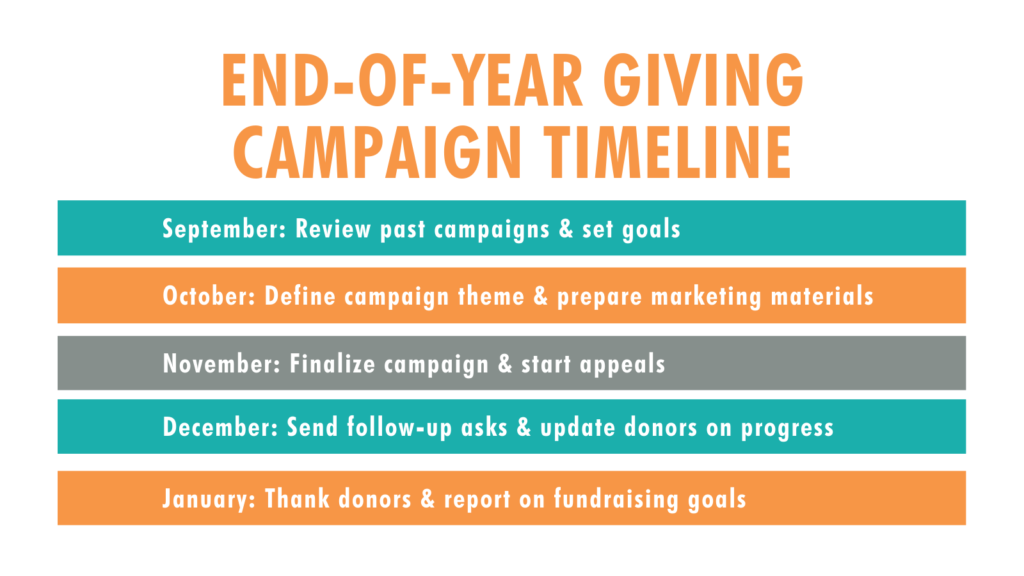 The year-end giving season is the most significant fundraising opportunity for most nonprofits. In fact, approximately 28% of nonprofits raise between 26–50% of their annual funds from their year-end ask.
The year-end giving season is the most significant fundraising opportunity for most nonprofits. In fact, approximately 28% of nonprofits raise between 26–50% of their annual funds from their year-end ask.
The biggest driving force behind end-of-year donations? The holidays. People tend to be more generous with their time and money and more likely to support the causes they care most about between Thanksgiving and New Year’s Eve. That’s why nearly 31% of annual giving occurs in December, and 12% of all giving happens in the last three days of the year.
With the holidays just around the corner, having a strategic giving campaign in place can help to maximize donations and ensure the success of your organization’s fundraising goals.
Here are five steps to help plan, create, and execute a successful year-end giving campaign this year.
1. Set a Goal and Timeline for the Year-End Giving Campaign
The earlier you start planning, the more effective the end-of-year giving campaign will be. Last-minute planning can be overwhelming not just for donors but also for staff and volunteers, who may have planned time off to enjoy the holidays with their own families.
The first thing to do when planning any fundraising campaign is to set strategic yet attainable goals and objectives. How much money do you need to raise? How many donors do you need to get? Whether you want to increase your funds raised from last year by 10% or find 100 new donors, remember to use the SMART goal-setting strategy to help guide your goals for your giving campaign.
When setting the timeline, don’t forget GivingTuesday, the Tuesday after Thanksgiving. Most nonprofits use this Global Day of Giving as the kick-off for their end-of-year giving campaigns.
This year’s #GivingTuesday is on November 30. So, early planning is essential to participate in this viral day of giving. Promote your participation in GivingTuesday a month before the event to prepare your repeat donors and broaden your audience.
#TeamStrategyTip: While you can use the GivingTuesday online toolkit, it is beneficial to create your own theme or hashtag to stand out from the crowd.
Determine Your Budget
It’s essential to set the budget at the beginning of the planning process. How much money is there to invest in the year-end giving campaign? Do you have the funds for professional photography or videography sessions? Knowing the budget can help determine your fundraising goals and your marketing strategies.
#TeamStrategyTip: Don’t forget to add a line item for paid social media advertising! Remember, the average organic reach on Facebook is only 5.2%. You want to make sure your followers actually see your carefully crafted campaign posts. During the busy holiday seasons, we recommend a spend of $15/day min. 2. Define the Year-End Giving Campaign Theme
2. Define the Year-End Giving Campaign Theme
Before you start building out the content, it’s critical to define your campaign theme — what is the feeling or emotion you want to evoke? What do you want people to know? The theme ties all your marketing materials together; it’s woven throughout your social media posts, your email blasts, your direct mail pieces, and your website. Having one central and consistent theme across all channels brands your campaign and makes it memorable for donors.
Communication Channels to Utilize for the Year-End Giving Campaign
Website: Create a separate landing page for the end-of-year fundraising. Make the link easy to find by including it on the navigation menu and the homepage. Make the donate button big and above the fold. Online giving increases every year, so a donation page that’s easy to find, easy to use, and secure is crucial.
Direct Mail: Yes, online giving has increased, but direct mail is still the most popular medium for year-end appeals and an effective outreach strategy when done right. In addition to including a donation envelope for checks, consider adding a QR code to your mailers to take people directly to your online donation page.
Email: Don’t forget to segment the donor list — past donors, current donors, prospective donors, and volunteers — to personalize communications and make the right ask. Develop a series of emails to keep in touch with each list throughout the campaign. Keep messages short and to the point with a clear call to action.
Social Media: When it comes to social media, it’s vital that you’re sharing a mix of regular, engaging posts throughout the campaign period — not just donation appeals. You want to inspire your followers, not lose them. Instead, sprinkle in staff profiles, board member bios, testimonials, success stories, “feel good” holiday content, and campaign milestones! Seeing your fundraising progress may help to build a sense of urgency in your subsequent donation posts.
Don’t forget to ask your staff, volunteers, and board members to be your Brand Ambassadors by sharing your fundraising posts on their own social media profiles for an added boost! If you have the time, you can even create a Year-End Giving Social Media playbook with suggested social media copy and graphics for them to use.
#TeamStrategyTip: Have you set up Instagram’s Donate sticker? If not, now is the time to do so! Instagram Stories are used by 500 million users each day. Go live on Instagram and shout out your donors. You can also host a volunteer Instagram take-over and have them share why they volunteer with you.
3. Use Compelling Stories in Your Campaign
Storytelling is the most important tool in your fundraising toolbox. Donors want to know their funds will make a difference, and collecting stories throughout the year will help to show that impact. Hearing directly from individuals with life-changing stories humanizes your organization and evokes emotions, inspiring your donors to give.
Start by interviewing everyone involved in your organization — staff members, board members, volunteers, clients, and even past donors. Everyone has a story to tell, and people naturally want to share their stories.
Once you have your stories, use them in your marketing collateral in various forms. Write blogs spotlighting individuals, share in newsletters, take photos, and don’t forget video! Whether you’re using your smartphone or a professional team, visual content like photos and videos can make for engaging and powerful content on both your social media and website.
4. Have a Clear Call-To-Action
You have your content ready to go; now it’s time to craft your messages for each channel and make sure you have a clear action people can take. This helps to increase the number of donations.
When making your ask, use impact statements. For example, a $10 donation provides a hot meal for your neighbor in need. A successful year-end giving campaign is donor-centric and human-first. Impact statements show exactly how the donor’s funds will be used and increase the likelihood of taking action and donating.
It should be easy to give. Remember, donations come in all sizes, and not everyone can give at the same level. Providing a range of giving levels while also leaving a write-in option for donors who prefer to give a different amount may actually help towards achieving your fundraising goals.
#TeamStrategyTip: Make the largest donation amount first in line.
5. Say “Thank you” to Everyone
Say thank you! Donors want to know that they made a difference — that’s why they donate. A personalized letter or video thanking and recognizing donors for their contribution, no matter how small, goes a long way in building a positive relationship. It will also increase the chances of them donating again.
And don’t forget to thank your staff and volunteers! No matter the results, your team’s effort, and hard work planning and executing this end-of-year giving campaign deserves recognition and celebration, so don’t leave them out of your “thank yous.”
#TeamStrategyTip: Turn your New Year’s Day post into a “Thank you” post, and include the progress report.
Last but not least, after you’ve had a chance to enjoy the end of the holiday season with your loved ones, don’t forget to look back and analyze the end-of-year giving campaign. Take a deep dive into what worked and what didn’t so you can continue to build on your annual giving campaigns.
Bonus Tip: Create an impact report and share it with everyone who participated in the campaign, including your staff, volunteers, board members, social media followers, and donors.
Worried you don’t have the capacity this year for a stellar year-end giving campaign? Our team is here to help! Contact us for a 15-min consultation call to see if we could be just what you need to meet your fundraising goals!
1 thoughts on “Year-End Giving: 5 Steps to Build a Successful Campaign”